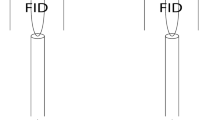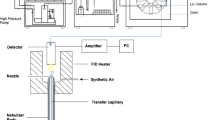Abstract
The concept of theoretical response factors is not directly applicable to methyl esters of short-chain fatty acids (FA), since their carbon deficiency is larger than expected from theory. Substituting the methyl group by an ethyl, propyl, or butyl group improved the flame-ionization efficiency of fatty acid esters gradually, up to the point where the empirical response factors of the butyl esters were identical within experimental error to the theoretical values. Butyl esters of FA have a uniform flame-ionization detection (FID) response irrespective of the number of carbon atoms contained in the FA. They exhibit a carbon deficiency of 1.0, i.e. the carbonyl carbon atom does not respond, as expected from theory. Compared to methyl esters, which have a carbon deficiency of 1.4–1.5 for short-chain FA, use of butyl esters has the advantage that a precalculation of the FID response enables the analyst to judge whether the analytical system employed works properly and the data produced are accurate and reliable. Both acid (BF3 or H2SO4)-and alkali (butoxide)-catalyzed butyl ester preparation were equally effective, giving the analyst a choice of methods so that different analytical needs can be addressed efficiently. Computing response factors and comparing the theoretically expected values with those obtained experimentally gives the experimenter an indication whether the analytical system employed for FA profiling (transesterification plus the subsequent gasliquid chromatographic separation and quantitation by FID) works properly. This setup is particularly useful for an accurate analysis of the FA profile of milk fat.
Similar content being viewed by others
References
Grob, K., Classical Split and Splitless Injection in Capillary GC, 2nd edn., Huethig, Heidelberg, 1988, p. 219.
Grob, K., On-Column Injection in Capillary Gas Chromatography, Huethig, Heidelberg, 1987, p. 1.
Craske, J.D., Separation of Instrumental and Chemical Errors in the Analysis of Oils by Gas Chromatography—A Collaborative Evaluation, J. Am. Oil Chem. Soc. 70:325–334 (1993).
Craske, J.D., and C.D. Bannon, Gas-Liquid Chromatography Analysis of the Fatty Acid Composition of Fats and Oils: A Total System for High Accuracy, Ibid.:1413–1417 (1987).
Ackman, R.G., and J.C. Sipos, Application of Specific Response Factors in the Gas Chromatographic Analysis of Methyl Esters of Fatty Acids with Flame Ionization Detectors, Ibid.:377–378 (1964).
Bannon, C.D., J.D. Craske, and A.E. Hilliker, Analysis of Fatty Acid Methyl Esters with High Accuracy and Reliability. IV. Fats with Fatty Acids Containing Four or More Carbon Atoms, Ibid.:1501–1507 (1985).
Bannon, C.D., J.D. Craske, and A.E. Hilliker, Analysis of Fatty Acid Methyl Esters with High Accuracy and Reliability. V. Validation of Theoretical Relative Response Factors of Unsaturated Esters in the Flame Ionization Detector, Ibid.:105–110 (1986).
Craske, J.D., C.D. Bannon, and L.M. Norman, Limitations of Ambient Temperature Methods for the Methanolysis of Triacylglycerols in the Analysis of Fatty Acid Methyl Esters with High Accuracy and Reliability, Ibid.:262–266 (1988).
Precht, D., Quantitative Detection of Milk Fat in Chocolate Mixtures. I. Determination of Milk Fat in Cocoa Butter, Fat Sci. Technol. 92:153–161 (1990).
Ulberth, F., Quantitation of Foreign Fat in Foreign Fat/Milkfat Mixtures by Multivariate Regression Analysis of Fatty Acid Data, J. Agric. Food Chem. 43:1556–1560 (1995).
Muuse, B., and R. Martens, Mixtures of Milkfat with Non-Milkfat—Determination of the Milkfat Content, Int. Dairy Fed. Bull. 285:65–69 (1993).
Ulberth, F., and F. Schrammel, Accurate Quantitation of Short-, Medium-, and Long-Chain Fatty Acid Methyl Esters by Split-Injection Capillary Gas-Liquid Chromatography. J. Chromatogr. A 704:455–463 (1995).
Christopherson, S.W., and R.L. Glass, Preparation of Milk Fat Methyl Esters by Alcoholysis in an Essentially Nonalcoholic Solution, J. Dairy Sci. 52:1289–1290 (1969).
Official Methods and Recommended Practices of the AOCS, American Oil Chemists’ Society, Champaign, 1992, Method Ce 2–66.
Ackman, R.G., and J.C. Sipos, Flame Ionization Detector Response for the Carbonyl Carbon Atom in the Carboxyl Group of Fatty Acids and Esters, J. Chromatogr. 16:298–305 (1964).
Ulberth, F., and M. Henninger, On-Column Injection of Fatty Acid Methyl Esters on to Polar Capillary Columns Without Distortion of Early Eluting Peaks, J. High Res. Chromatogr. 15:54–56 (1992).
Scanlon, J.T., and D.E. Willis, Calculation of Flame Ionization Detector Relative Response Factors Using the Effective Carbon Number Concept, J. Chromatogr. Sci. 23:333–340 (1985).
Katritzky, A.R., E.S. Ignatchenko, R.A. Barcock, V.S. Lovanov, and M. Karelson, Prediction of Gas Chromatographic Retention Times and Response Factors Using a General Quantitative Structure-Property Relationship Treatment, Anal. Chem. 66:1799–1807 (1994).
Parodi, P.W., Observations on the Variation in Fatty Acid Composition of Milkfat, Aust. J. Dairy Technol. 27:90–94 (1972).
Iverson, J.L., and A.J. Sheppard, Determination of Fatty Acids in Butter Fat Using Temperature-Programmed Gas Chromatography of the Butyl Esters, Food Chem. 21:223–234 (1986).
Author information
Authors and Affiliations
Corresponding author
About this article
Cite this article
Ulberth, F., Gabernig, R.G. & Schrammel, F. Flame-ionization detector response to methyl, ethyl, propyl, and butyl esters of fatty acids. J Amer Oil Chem Soc 76, 263–266 (1999). https://doi.org/10.1007/s11746-999-0228-7
Received:
Accepted:
Issue Date:
DOI: https://doi.org/10.1007/s11746-999-0228-7




